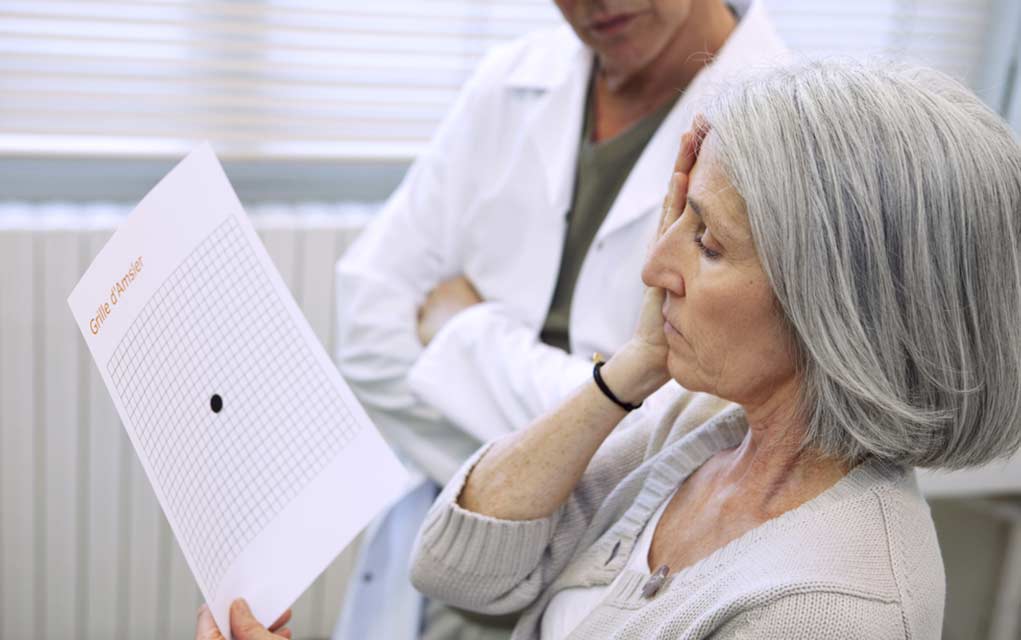What You Need to Know About Macular Degeneration

Most of us depend on our eyesight in nearly everything we do. And we might not realize how much we use our eyes until our vision begins to fail. Macular degeneration causes more vision loss among older U.S. residents than any other health issue, so it’s important to know the warning signs as early intervention may help.
Macular degeneration is the biggest cause of age-related vision loss in the United States. It can be hard to detect until it reaches its late stage, but symptoms can include reduced visual acuity, distortions and blind spots in the central vision, which can make it difficult to make out faces, read and see other details. Being female, overweight, blue-eyed, far-sighted, a smoker and/or having cardiovascular disease or high blood pressure all increase the risk. Genetic factors can come into play, as well as the time spent outdoors in the sun. Macular degeneration comes in “wet and “dry forms, the latter usually being far more severe and progressing much quicker. A rare, genetic form, Stargardt disease, strikes children and teenagers. There’s no cure for macular degeneration, but some medications may slow the disease’s progression. We have more facts for you.
Understanding Macular Degeneration
As we age, we may start to notice a waning in our visual acuity. This can be much more profound in some people, the result of an irreversible disease of the eyes. Macular degeneration occurs when the central part of the retina, a membrane in the back of the eye that turns images into signals for the optic nerve to send to the brain, deteriorates. Over time, this results in a loss of central vision, making it hard to see faces, read or make out other specific details.
Age is the biggest risk factor for developing macular degeneration, but there are sometimes additional elements. Your risk could be higher than normal if you:
- are female.
- have blue eyes.
- are overweight.
- suffer from cardiovascular issues or high blood pressure.
- are genetically predisposed.
- are far-sighted.
- smoke.
- have high levels of C-reactive protein (CRP).
- spend a lot of time out in the sun.
It’s important to know the personal risks, so you can be on the lookout for early warning signs and see an optometrist right away if you suspect you may be predisposed.
Dry and Wet Forms
The most common type of macular degeneration, accounting for 85% to 90% of cases, is the dry form. It’s usually slow to progress, often first manifesting as fluctuating vision and difficulty seeing in low light. Although the cause is still a bit of a mystery, doctors do know sufferers develop small, pigmented deposits, or drusen, under the macula. These areas can slowly dry out the retina and disrupt the eye’s ability to function.
The wet form occurs when these changes lead to abnormal blood vessel growth beneath the macula. The blood vessels can bleed into the retina, causing fluid to build up, resulting in profound central vision loss. People with this form of the disease often experience dark spots in their central vision and rapid eyesight deterioration. All cases of wet macular degeneration begin as the dry form.
A rare form of the condition, called Stargardt disease, strikes children and teenagers. It’s caused by a genetic mutation that disrupts the retina’s ability to remove waste materials, causing normal building blocks like vitamin A to become toxic in high amounts. There’s still no treatment, but researchers are hopeful that a cure is on the horizon. All the more reason to speak to an optometrist at the earliest suspicions.
Disease Stages
Regardless of the form it takes, macular degeneration is progressive. Sufferers all undergo three stages:
- Early disease is often unnoticeable but can be detected in an eye exam.
- The intermediate disease may or may not cause noticeable symptoms but will present with larger drusen upon a visual exam.
- Late-stage disease causes noticeable vision loss.
Because most of us will not be aware of early-stage or intermediate disease, regular eye exams are essential to identifying all stages of macular degeneration. You can also use an Amsler grid, which is basically a swatch of graph paper, to test your vision at home. Any wavy or missing lines indicate a problem.
Minimizing Risks
There are some macular degeneration risk factors, like genetics, that we can’t do much about. But we can take charge of the few variables within our control. If you smoke cigarettes, quit. If you’re overweight or have been letting your cardiovascular health slide, change your diet and talk to your doctor about starting an exercise regimen. Wear protective eyewear that blocks out both UVA and UVB rays, with a rating of “UV 400, when going outside in the sun.
For those who have already begun to develop macular degeneration, talk to an eye-doctor about treatment options and discuss any current prescriptions that could worsen the condition. There’s still no cure, but some medications may also slow the disease’s progression.
Macular degeneration can strike nearly anyone, and no age group is immune. Be aware of the risks and keep up on eye exams. Our vision is precious let's preserve it for as long as we can.

Related Keywords







